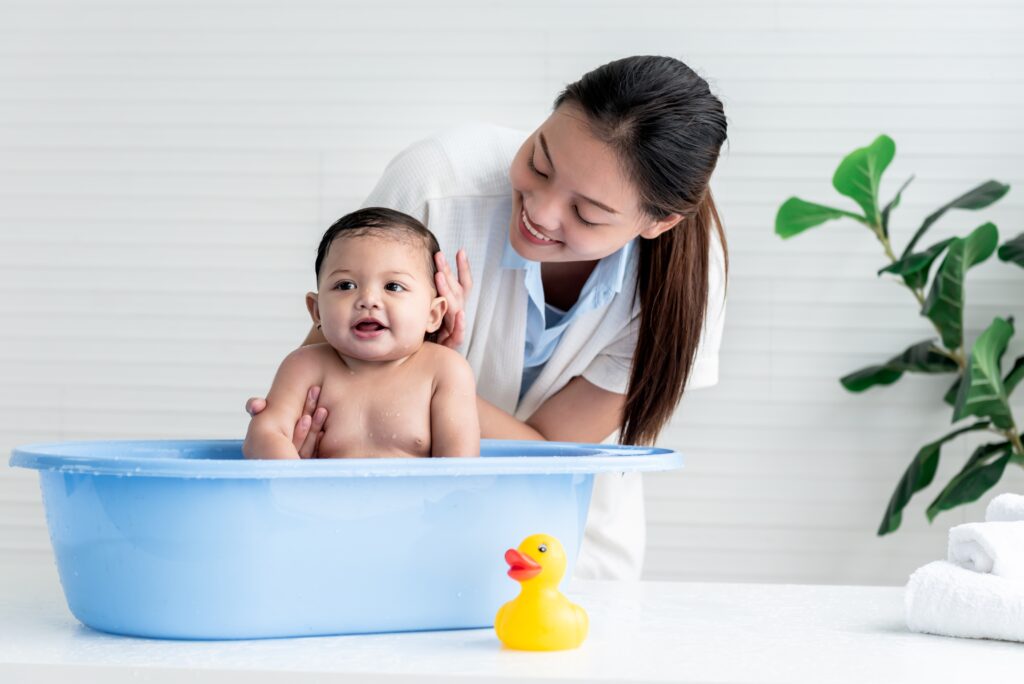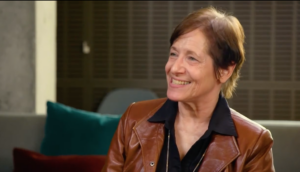
Structure Up!
Children thrive when they are provided with a predictable, structured environment. Routines provide a sense of safety and security, as well as foster healthy emotional and
As parents, we get so much feedback about what we can do to enhance our baby’s development. Sometimes, it can be difficult to remember one of the best parts—playing together! In The CuddleBright Parenting Guide, we learn about the many benefits of play to early child development, the parent-child relationship, and lifelong thriving. But, research has found that children are playing less and less these days, and there is no replacement for relationships—even during these earliest years. One key culprit is the alluring draw of technology and screentime, which is not a replacement for quality time with you.
A Prescription for Play
Did you know that play is so important that the American Academy of Pediatrics (AAP) recommends that pediatricians prescribe play in early childhood?
Play Ideas During Daily Routines
It can be awkward to play as an adult, though, and sometimes difficult to come up with ways to connect with your little one in play. Here are some ideas for how you can integrate play into your daily routines throughout the day.
Playtime
Young children really enjoy when you follow their lead and join in their play. Observe what your child is drawn to, and then join in by taking a turn, commenting on what you see them doing, or adding in a new idea. Maybe they love the colorful shape sorter. Take a turn putting the pieces in! Then, sneak one behind your back and have it magically reappear. Show your excitement in the small, tender moments by describing what is happening (“Here comes the blue one!” “Oh no! It can’t fit there!”). Hearing your voice makes play more engaging, plus it models the power of communication, enriching your little one’s language development, too.
Bath time
We don’t need elaborate toys to make play fun! Next bath time, you might watch for what your child enjoys about the water. Does he splash his hands up and down? Does he pour water from cups? Does he reach for your hands or face? Or, maybe he loves pretend and make-believe. Remember, find the anchor in what he chooses on his own—then join in and expand! Take turns splashing, exclaim, “you got me!” after a big splash, or, “Ah! My face is wet!” after he pats you on the cheek with dripping hands. If he loves pouring things in and out, bring different size and color cups into the bath and take turns pouring. If you are bathing in baby tubs, you might pour a little bit of water on his tummy while pausing for a moment—waiting for that giggle or reach before starting back again. For the pretend play fan, try building a game of ‘hair salon’ where your child chooses whether he wants purple or blue hair today. Every child is different—and what is fun today might not be the next day. Just like we want to encourage our children to experiment, try out different activities until you find something you both enjoy!

Singing Songs
Think about those favorite songs you sing to your baby. Not only are these a great way to establish those routines and rituals for the two of you, but you can also use it for playtime! Add animated actions, like clapping or tapping her nose on a favorite part. Or, try freezing at favorite moments in the song with a ‘What is going to happen next’ expression. Then, sing the next line after a shared moment of anticipation. As your child gets a little bit older, you can throw in a silly ‘wrong word’ here and there—watch them laugh and join in with a reciprocal “oops” on the next verse! Whatever you do, pick a familiar song your toddler enjoys, remember that repetition is your friend, and get animated (this can include varying the tone of your voice, as well as using big facial expressions and body movements). You can even try this activity with songs from CuddleBright here!
Wake up
Wake up from a nap or nighttime is a great time for a good old-fashioned game of peek-a-boo. Watch Dada disappear behind the crib wall and pop up again! Now it’s baby’s turn! After a couple rounds of taking turns with parent and baby, you might even try having baby’s favorite stuffed animal or CuddleBright lovie play peek-a-boo behind the crib and back! Or, perhaps your baby is in the mood for some tickles—“Uh oh! Here comes the tickle bug! I’m going to get you!” These games might last just a couple brief minutes before you reunite in a big bear hug.
Mealtime
One of the best things about play is that there aren’t really rules! As long as it is engaging and enjoyable—it can be play! For some families, a favorite time to play is during mealtime. Have you ever noticed how your baby laughs when the spoon falls off the table—and then seems to want to do it again and again after you pick it up? Babies learn and thrive on repetition, and you can use it to make a game. Choose something you are OK with rolling off the highchair—and do it again and again while narrating what is happening—“Fall down!” “Here it is!” After a few rounds, try balancing that object on your head—“Ah ah ah-choo!” as it falls to the floor! As you will find, we often don’t need fancy or formal toys for play. Young children find joy in the everyday, and we can join into that fun, too!
Listen to Dr. Kathy Hirsh-Pasek elaborate on the different kinds of play you can explore with your baby or toddler, and the important reasons why they matter. Remember, this article shares just a few examples of play. Have fun making it your own—a special shared experience for just you and your loved ones—let’s go have fun!

Children thrive when they are provided with a predictable, structured environment. Routines provide a sense of safety and security, as well as foster healthy emotional and

Just think of how much time babies spend in routines of one kind or another: sleeping, bathing, feeding, and diaper changing, not to mention dressing,

Like the child’s Lovie, the job of the CuddleBright Keepsake Heart is to be a transitional object, providing the parent with something tangible to touch

Children thrive when they are provided with a predictable, structured environment. Routines provide a sense of safety and security, as well as foster healthy emotional and

Just think of how much time babies spend in routines of one kind or another: sleeping, bathing, feeding, and diaper changing, not to mention dressing,

It’s hard to wait! It can be hard for adults, and it’s even harder for young children. Psychologist Walter Mischel and colleagues have spent decades

An excerpt from a behind-the-scenes interview with Dr. Kathy Hirsh-Pasek at the 2018 Simms/Mann Institute Think Tank

Children thrive when they are provided with a predictable, structured environment. Routines provide a sense of safety and security, as well as foster healthy emotional and
| Cookie | Duración | Descripción |
|---|---|---|
| __stripe_mid | 1 year | Stripe sets this cookie cookie to process payments. |
| __stripe_sid | 30 minutes | Stripe sets this cookie cookie to process payments. |
| cookielawinfo-checkbox-advertisement | 1 year | Set by the GDPR Cookie Consent plugin, this cookie is used to record the user consent for the cookies in the "Advertisement" category . |
| cookielawinfo-checkbox-analytics | 11 months | This cookie is set by GDPR Cookie Consent plugin. The cookie is used to store the user consent for the cookies in the category "Analytics". |
| cookielawinfo-checkbox-functional | 11 months | The cookie is set by GDPR cookie consent to record the user consent for the cookies in the category "Functional". |
| cookielawinfo-checkbox-necessary | 11 months | This cookie is set by GDPR Cookie Consent plugin. The cookies is used to store the user consent for the cookies in the category "Necessary". |
| cookielawinfo-checkbox-others | 11 months | This cookie is set by GDPR Cookie Consent plugin. The cookie is used to store the user consent for the cookies in the category "Other. |
| cookielawinfo-checkbox-performance | 11 months | This cookie is set by GDPR Cookie Consent plugin. The cookie is used to store the user consent for the cookies in the category "Performance". |
| CookieLawInfoConsent | 1 year | Records the default button state of the corresponding category & the status of CCPA. It works only in coordination with the primary cookie. |
| elementor | never | This cookie is used by the website's WordPress theme. It allows the website owner to implement or change the website's content in real-time. |
| viewed_cookie_policy | 11 months | The cookie is set by the GDPR Cookie Consent plugin and is used to store whether or not user has consented to the use of cookies. It does not store any personal data. |
| Cookie | Duración | Descripción |
|---|---|---|
| mailchimp_landing_site | 1 month | The cookie is set by MailChimp to record which page the user first visited. |
| Cookie | Duración | Descripción |
|---|---|---|
| _ga | 2 years | The _ga cookie, installed by Google Analytics, calculates visitor, session and campaign data and also keeps track of site usage for the site's analytics report. The cookie stores information anonymously and assigns a randomly generated number to recognize unique visitors. |
| _gat_gtag_UA_46801669_2 | 1 minute | Set by Google to distinguish users. |
| _gid | 1 day | Installed by Google Analytics, _gid cookie stores information on how visitors use a website, while also creating an analytics report of the website's performance. Some of the data that are collected include the number of visitors, their source, and the pages they visit anonymously. |
| tk_lr | 1 year | The tk_lr is a referral cookie set by the JetPack plugin on sites using WooCommerce, which analyzes referrer behaviour for Jetpack. |
| tk_or | 5 years | The tk_or is a referral cookie set by the JetPack plugin on sites using WooCommerce, which analyzes referrer behaviour for Jetpack. |
| tk_r3d | 3 days | JetPack installs this cookie to collect internal metrics for user activity and in turn improve user experience. |
| tk_tc | session | JetPack sets this cookie to record details on how user's use the website. |
| Cookie | Duración | Descripción |
|---|---|---|
| cookies.js | session | No description available. |
| m | 2 years | No description available. |